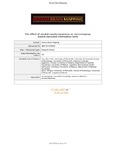The effect of mental countermeasures on neuroimaging-based concealed information tests
| dc.contributor.author | Hsu, C-W | |
| dc.contributor.author | Begliomini, C | |
| dc.contributor.author | Dall'Acqua, T | |
| dc.contributor.author | Ganis, Giorgio | |
| dc.date.accessioned | 2019-03-13T10:48:42Z | |
| dc.date.issued | 2019-03-12 | |
| dc.identifier.issn | 1065-9471 | |
| dc.identifier.issn | 1097-0193 | |
| dc.identifier.uri | http://hdl.handle.net/10026.1/13459 | |
| dc.description.abstract |
<jats:title>Abstract</jats:title><jats:sec><jats:label /><jats:p>During the last decade and a half, functional magnetic resonance imaging (fMRI) has been used to determine whether it is possible to detect concealed knowledge by examining brain activation patterns, with mixed results. Concealed information tests rely on the logic that a familiar item (probe) elicits a stronger response than unfamiliar, but otherwise comparable items (irrelevants). Previous work has shown that physical countermeasures can artificially modulate neural responses in concealed information tests, decreasing the accuracy of these methods. However, the question remains as to whether purely mental countermeasures, which are much more difficult to detect than physical ones, can also be effective. An fMRI study was conducted to address this question by assessing the effect of attentional countermeasures on the accuracy of the classification between knowledge and no‐knowledge cases using both univariate and multivariate analyses. Results replicate previous work and show reliable group activation differences between the probe and the irrelevants in fronto‐parietal networks. Critically, classification accuracy was generally reduced by the mental countermeasures, but only significantly so with region of interest analyses (both univariate and multivariate). For whole‐brain analyses, classification accuracy was relatively low, but it was not significantly reduced by the countermeasures. These results indicate that mental countermeasure need to be addressed before these paradigms can be used in applied settings and that methods to defeat countermeasures, or at least to detect their use, need to be developed.</jats:p></jats:sec><jats:sec><jats:title>Highlights</jats:title><jats:p> <jats:list list-type="bullet"> <jats:list-item><jats:p>FMRI‐based concealed information tests are vulnerable to mental countermeasures</jats:p></jats:list-item> <jats:list-item><jats:p>Measures based on regions of interest are affected by mental countermeasures</jats:p></jats:list-item> <jats:list-item><jats:p>Whole‐brain analyses may be more robust than region of interest ones</jats:p></jats:list-item> <jats:list-item><jats:p>Methods to detect mental countermeasure use are needed for forensic applications</jats:p></jats:list-item> </jats:list></jats:p></jats:sec> | |
| dc.format.extent | 2899-2916 | |
| dc.format.medium | Print-Electronic | |
| dc.language | en | |
| dc.language.iso | en | |
| dc.publisher | Wiley | |
| dc.rights | Attribution-NonCommercial-ShareAlike 4.0 International | |
| dc.rights | Attribution-NonCommercial-ShareAlike 4.0 International | |
| dc.rights | Attribution-NonCommercial-ShareAlike 4.0 International | |
| dc.rights | Attribution-NonCommercial-ShareAlike 4.0 International | |
| dc.rights | Attribution-NonCommercial-ShareAlike 4.0 International | |
| dc.rights | Attribution-NonCommercial-ShareAlike 4.0 International | |
| dc.rights | Attribution-NonCommercial-ShareAlike 4.0 International | |
| dc.rights.uri | http://creativecommons.org/licenses/by-nc-sa/4.0/ | |
| dc.rights.uri | http://creativecommons.org/licenses/by-nc-sa/4.0/ | |
| dc.rights.uri | http://creativecommons.org/licenses/by-nc-sa/4.0/ | |
| dc.rights.uri | http://creativecommons.org/licenses/by-nc-sa/4.0/ | |
| dc.rights.uri | http://creativecommons.org/licenses/by-nc-sa/4.0/ | |
| dc.rights.uri | http://creativecommons.org/licenses/by-nc-sa/4.0/ | |
| dc.rights.uri | http://creativecommons.org/licenses/by-nc-sa/4.0/ | |
| dc.subject | concealed knowledge | |
| dc.subject | countermeasures | |
| dc.subject | memory detection | |
| dc.subject | neuroimaging | |
| dc.title | The effect of mental countermeasures on neuroimaging-based concealed information tests | |
| dc.type | journal-article | |
| dc.type | Journal Article | |
| dc.type | Research Support, Non-U.S. Gov't | |
| plymouth.author-url | https://www.webofscience.com/api/gateway?GWVersion=2&SrcApp=PARTNER_APP&SrcAuth=LinksAMR&KeyUT=WOS:000470788400004&DestLinkType=FullRecord&DestApp=ALL_WOS&UsrCustomerID=11bb513d99f797142bcfeffcc58ea008 | |
| plymouth.issue | 10 | |
| plymouth.volume | 40 | |
| plymouth.publication-status | Published | |
| plymouth.journal | Human Brain Mapping | |
| dc.identifier.doi | 10.1002/hbm.24567 | |
| plymouth.organisational-group | /Plymouth | |
| plymouth.organisational-group | /Plymouth/Faculty of Health | |
| plymouth.organisational-group | /Plymouth/Faculty of Health/School of Psychology | |
| plymouth.organisational-group | /Plymouth/REF 2021 Researchers by UoA | |
| plymouth.organisational-group | /Plymouth/REF 2021 Researchers by UoA/UoA04 Psychology, Psychiatry and Neuroscience | |
| plymouth.organisational-group | /Plymouth/REF 2021 Researchers by UoA/UoA04 Psychology, Psychiatry and Neuroscience/UoA04 REF peer reviewers | |
| plymouth.organisational-group | /Plymouth/Research Groups | |
| plymouth.organisational-group | /Plymouth/Research Groups/Centre for Brain, Cognition and Behaviour (CBCB) | |
| plymouth.organisational-group | /Plymouth/Research Groups/Centre for Brain, Cognition and Behaviour (CBCB)/Brain | |
| plymouth.organisational-group | /Plymouth/Users by role | |
| plymouth.organisational-group | /Plymouth/Users by role/Academics | |
| dc.publisher.place | United States | |
| dcterms.dateAccepted | 2019-02-26 | |
| dc.rights.embargodate | 2020-3-11 | |
| dc.identifier.eissn | 1097-0193 | |
| dc.rights.embargoperiod | Not known | |
| rioxxterms.versionofrecord | 10.1002/hbm.24567 | |
| rioxxterms.licenseref.uri | http://creativecommons.org/licenses/by-nc-sa/4.0/ | |
| rioxxterms.licenseref.startdate | 2019-03-12 | |
| rioxxterms.type | Journal Article/Review |



